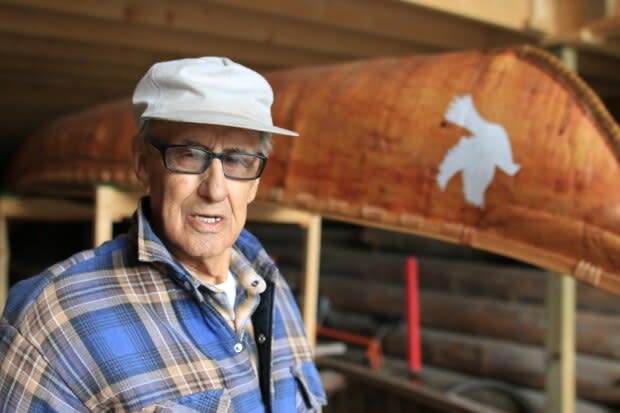Madawaska mural project honours community elders
Maliseet Auto, an automotive garage in Madawaska First Nation, got a new look over the summer, and it has nothing to do with cars.
Edmundston artist Steve Rousselle spent the better part of the summer with an air brush and spray-paint cans painting local Wolastoqi elder Noel Francis Jr. on one side of the old building, and his late father, Noel Francis Sr., on another side.
"My father was the first chief that was elected in 1956, that's after 1951, under the Indian Act," Francis Jr. said. "There was chiefs here before, but my father was the first chief on the reserve here, and he served for three terms from 1956 to 1962."
Prior to the 1951 amendments to the Indian Act, all band affairs were handled by non-Indigenous government officials known as Indian agents.

When the Indian Act was changed, it put power back into the hands of First Nations peoples by allowing them to govern their own communities through band-elected chiefs and councils.
Francis Jr., now 83, is known around the community as a builder of birch-bark canoes, a skill he learned later in life. His old brick building that houses the garage now shows Francis Jr. with one of his canoes.
"That represents a history also because I was a chief for four years after my father," Francis Jr. said.
Rousselle said the project started when he presented the idea of doing a mural to Madawaska First Nation Coun. Donna Wallace.
"I presented a few ideas I had in my head, and she said,'It's a great idea, you should come and present it to the First Nation,'" Rousselle said.
Rousselle met with Chief Patricia Bernard and came up with an idea to honour Francis Jr. on the Maliseet Auto building.
"When it was approved, we started painting as soon as possible," Rousselle said.

"I had the honour to get to know Mr. Francis in the process, and the man's, like, totally awesome," Rousselle said.
"You know, it's like he builds canoes, he's passionate and he knows his culture, and he wants to, you know, leave something for the next generations and, you know, I think he did a nice nice gesture … letting us do something creative on his building."
The initial plan was to just do a single mural of Francis Jr., but after seeing it, Francis Jr. decided he also wanted one on the other side of the garage, a wall he could see from his house. He called Rousselle to let him know he wanted a mural of his father, who died in 1976.
"I said 'OK, Mr. Francis, I know it's windy, and we're gonna start soon, no worries,'" Rousselle said of the conversation. "So he said, 'No, I'm not calling you for that. I want you to paint the other side.'"
Bernard said the reaction to the murals has been positive.
"Everybody thinks it's a beauty," she said. "The man did a beautiful job and if anybody knew Noel Francis Sr., they immediately knew who it was.
"So it was very positive feedback, a lot of comments. It took a sort of rundown building and made it into a piece of art, which is quite fantastic."

In addition to the paintings of Noel Francis Jr. and his father are a muskrat and other symbols that have cultural significance to the Wolastoqiyik.
Bernard said having cultural art and symbols around the community is important for the nation.
"It's very important because not only does it instill a sense of pride in the community, but it brings us back to asking questions about what do these symbols mean and what why is the muskrat part of our culture and things of that nature," she said.
"So it raises questions, which then in turn poke at the curiosity, and people start to learn more, and not just our people but people outside the community as well."


